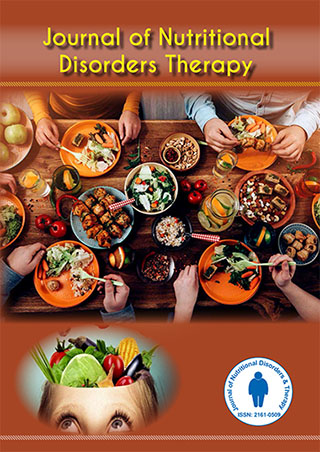インデックス付き
- Jゲートを開く
- Genamics JournalSeek
- アカデミックキー
- ジャーナル目次
- ウルリッヒの定期刊行物ディレクトリ
- レフシーク
- ハムダード大学
- エブスコ アリゾナ州
- OCLC-WorldCat
- パブロン
- ジュネーブ医学教育研究財団
- ユーロパブ
このページをシェアする
ジャーナルチラシ

概要
栄養会議 2015: リンポポ州ヴェンベ地区の妊婦の食習慣と 0 ~ 6 週の乳児の身体計測値の関係 - ムシャフィ L F - ヴェンダ大学
ムシャフィLF
背景:多くの南アフリカ人の食事は、お粥を主食とし、通常は野菜、豆類、少量の動物性食品と一緒に摂取されます。バランスの取れた食事を摂取しないと、妊娠中の体重増加が悪くなり、早産、低出生体重、先天異常の危険性が高まります。
目的: 0~6週齢の乳児の人体計測値を参考にして母親の食習慣を明らかにする。
設定:この研究は、南アフリカのリンポポ州ヴェンベ地区の4つの診療所で実施されました。
方法:横断的表現研究は、ベンベ地区の 4 つのクリニックから都合よく選ばれた 240 人の妊婦とその幼児を対象に実施されました。人体計測は標準的な手法に従って行われました。食習慣に関するデータと社会人口統計情報は質問票を使用して収集され、許可と承認が得られ、参加者の権利が尊重されました。
この研究は、南アフリカの農村における妊婦の食習慣、妊娠中の母親の体重と乳児の体重の関係に関するデータを提供する初めての研究です。今回の研究結果から、今回の研究の参加者のほとんどが非常に若年であることが明らかになりました。思春期の若者は、妊娠中に栄養的に何が必要なのか正確にはよくわかっていません。おそらくこれは、この段階の思春期の若者は、妊娠による栄養とエネルギーの増加に対応し、十分な体重増加を維持するために、多様な食事を必要とするという事実に起因する可能性があります。今回の研究結果から、今回の研究の参加者の大多数が妊娠中に体重が増えなかったことが明らかになりました。貧困層の女性は妊娠中に体重が増えにくく、微量栄養素の摂取量も少ない傾向があり、これが妊娠の結果に悪影響を及ぼす可能性があります。
The findings of the study revealed that majority of the participants were unemployed. Surprisingly there is no significant difference between the employment status of the mother and Z-scores of children (WAZ (p=0.700), HAZ (p=0.553) and BAZ (p=0.728). However, women living in low socio economic status are often malnourished before pregnancy due to inadequate food intake putting them at higher risk of having low birth and preterm delivery. Nevertheless, unemployment did not affect the z-scores of the infants in the current study. These findings are congruent with previous study done in Nigeria which indicated that majority of pregnant mothers were unemployed. In addition, poor weight of the pregnant women influenced by the socio-economic status of her family has a direct effect on the birth weight of her child. About 41.7% of the participants in the current study spend R1000-R2000 on food while 36.7% of the participants spend R500-R1000 on food. Perhaps this variation on money spend on food could be attributed to the household income and employment status of the members of household. Studies have shown relationship between dietary diversity, socioeconomic status and demographic characteristics.
The findings of the study revealed that participants ate three meals per day. Regular meals are not expected to be skipped during pregnancy, nutritious foods are directly linked to higher chance of a normal birth weight, improving brain development and reducing the risk of many birth defects. “Post-partum outcomes for mother and infants are linked to maternal consumption habits during pregnancy.
In addition, one of the main meals in the current study comprised of starchy foods. Starchy foods eaten in the present study include porridge, rice, samp and bread. The findings of the current study correlate with the study done in Ethiopia. “Adequate consumption of starchy food during pregnancy is known to support rapid growth of the foetus and also assist in maintaining weight gain during pregnancy”. The participants in the current study ate meat, legumes and dairy product. “Outcome of the pregnancy depends on the mother’s health. Consumption of protein food during pregnancy is vital to support growth of the foetus and this is linked to low risk of neonatal death and birth defects”. These findings are congruent with study done in Nigeria were it was reported that participants ate meat and meat products including those from home owned animals.
The most indigenous vegetables consumed in the current study were Delele, Vowa and Phuri. Access to indigenous food has been shown to be key determinant of dietary adequacy and consumption of these foods high in iron content. “Access to indigenous food has been shown to be key determinant of dietary adequacy therefore consumption of these foods is a key consideration during pregnancy”.
The findings of the study revealed that participants had pica during pregnancy. Consumption of non- food items in large quantities is common among pregnant women in rural villages and this could cause intestinal obstructions interfering with the absorption of essential nutrients which are vital for the growth of the foetus [26]. This is due to the fact that women lack of knowledge concerning the effects of pica on the foetus. Non-food items consumption during pregnancy can lead to malnutrition and deficiencies of vitamins and minerals. These findings are congruent with previous studies which indicated that pregnant women have been practicing pica and this can cause complication during pregnancy.
During pregnancy women are restrict to eat certain food items according to culture and this could result in fewer food consumption which in turn can lead to underweight and overweight. Surprisingly our study indicates negative correlation between mother’s BMI and the infant’s WAZ (r=-0.48; p=0.515). These indicate that the mother’s weight during pregnancy is not only the contributing factor to infant’s weight during birth. Factors such as dietary practices during pregnancy should be considered when studying the relationship between the mother’s weight during pregnancy and their infants during birth. However, women who have poor weight gain during pregnancy face greater risks of delivery preterm babies and their infants set off on a weaker development path, both physically and intellectually.25 Furthermore, Girls born with low birth weight are more likely to become poorly nourished children and poorly grown women and are, therefore, likely to give birth to low birth weight infants resulting in the vicious cycle of malnutrition [14]. In addition, nutritional status of mothers is one of the most important factors of foetal growth and development.
Results: 45 percent of the study participants have eaten carrots, bananas, apples, spinach, cabbage and beetroots during pregnancy while 26.7% of the study participants reported that they need eaten carrots, oranges, bananas, apples, spinach, cabbage and beetroots during pregnancy. The majority of participants (91.7%) received folate and iron supplements while 8.3% received iron, folate and calcium supplements during pregnancy. Half of the participants at the time of pregnancy had normal BMI, 13.3% were underweight, 30% were observed overweight and 6.7% were observed obese. More than third quarter of infants (80%) at birth had normal WAZ (-1SD to ≤+2SD), 6.7% of infants were underweight (<-3SD to <-2SD) while 11.7% of infants were mildly underweight (-2SD to <-1SD).
結論:母親の年齢と妊娠中の食習慣は出産結果に重大な影響を及ぼします。妊娠中の母親の体重は、出産時の乳児の体重に影響を与える唯一の要因ではありません。妊娠中の母親の体重と乳児の関係を研究する際には、妊娠中の食習慣や社会経済的地位などの要因を考慮する必要があります。低体重、消耗、発育不全の蔓延は、妊娠中の体重増加の低さと母親の不適切な食事 (不均衡な食事) によるものです。妊娠中に栄養不足だった母親は、低出生体重児を出産していました。
注:この研究の一部は、2015年10月26日〜28日に米国イリノイ州シカゴで開催された第4回国際栄養会議・展示会で発表されたものです。